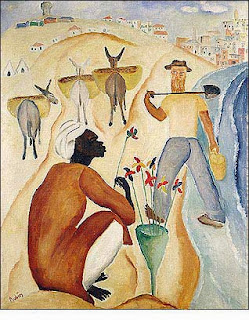Rueven Rubin, painter, born Romania 1893, died Israel 1974,
We were so busy preparing my daughter's Bat Mitzva on this visit that I didn't get to do much other than eat hummus (!) However one afternoon Irad and I went across the street to a very small museum on Bialik Street. It is right next to the better known Bialik House, down the street from the Museum of the History of Tel Aviv, and it is a little gem of a museum set in the artist's house-turned-museum. The third floor of the house is his actual studio, preserved as if he were still at work.
It is an enchanting museum that can be seen in an hour (my favorite kind), and not necessarily on the mainstream tourist path. But I found myself lost in the past and bathed in the feeling of an earlier time, through the naive yet sensuous luminosity of the paintings. The late days of Palestine and early days of Israel were laced with hardship, but for the artist with imagination they were a veritable paradise of visual exotica.
The exhibit currently on display was brilliant - it took paintings by Rubin and juxtaposed them with carefully researched archival photographs that showed nearly identical scenes from the same time. One could get a very clear sense of the sights to which Rubin responded in his paintings.
folkloric-like scenes of Jewish life,
the Arab and Yemenite peoples,
biblical-like scenery,
the early settlement city-scapes,

 There is a very interesting documentary about Rubin that plays at the museum. He speaks of starting off with only four colors of paint, because that is all he saw in the early days: sand, and sky.
There is a very interesting documentary about Rubin that plays at the museum. He speaks of starting off with only four colors of paint, because that is all he saw in the early days: sand, and sky.
self portrait with flower
The flower represents himself ready to flourish as an artist. And later his palate expands considerably!
Bialik Street is a great way to spend an afternoon, with the small museums in their original buildings and the historic cafe at the entrance to the street with its nightly jazz music. Rubin House itself is well worth an hour of time to lose oneself in another world, yet a world that is still visible through the current urban collage of modern Tel Aviv.

.gif)










No comments:
Post a Comment